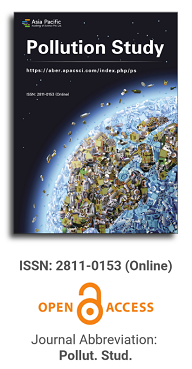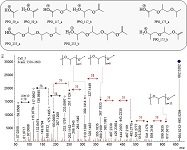
Asia Pacific Academy of Science Pte. Ltd. (APACSCI) specializes in international journal publishing. APACSCI adopts the open access publishing model and provides an important communication bridge for academic groups whose interest fields include engineering, technology, medicine, computer, mathematics, agriculture and forestry, and environment.

The (partial) replacement of synthetic polymers with bioplastics is due to increased production of conventional packaging plastics causing for severe environmental pollution with plastics waste. The bioplastics, however, represent complex mixtures of known and unknown (bio)polymers, fillers, plasticizers, stabilizers, flame retardant, pigments, antioxidants, hydrophobic polymers such as poly(lactic acid), polyethylene, polyesters, glycol, or poly(butylene succinate), and little is known of their chemical safety for both the environment and the human health. Polymerization reactions of bioplastics can produce no intentionally added chemicals to the bulk material, which could be toxic, as well. When polymers are used to food packing, then the latter chemicals could also migrate from the polymer to food. This fact compromises the safety for consumers, as well. The scarce data on chemical safety of bioplastics makes a gap in knowledge of their toxicity to humans and environment. Thus, development of exact analytical protocols for determining chemicals of bioplastics in environmental and food samples as well as packing polymers can only provide warrant for reliable conclusive evidence of their safety for both the human health and the environment. The task is compulsory according to legislation Directives valid to environmental protection, food control, and assessment of the risk to human health. The quantitative and structural determination of analytes is primary research task of analysis of polymers. The methods of mass spectrometry are fruitfully used for these purposes. Methodological development of exact analytical mass spectrometric tools for reliable structural analysis of bioplastics only guarantees their safety, efficacy, and quality to both humans and environment. This study, first, highlights innovative stochastic dynamics equations processing exactly mass spectrometric measurands and, thus, producing exact analyte quantification and 3D molecular and electronic structural analyses. There are determined synthetic polymers such as poly(ethylenglycol), poly(propylene glycol), and polyisoprene as well as biopolymers in bags for foodstuffs made from renewable cellulose and starch, and containing, in total within the 20,416–17,495 chemicals per sample of the composite biopolymers. Advantages of complementary employment in mass spectrometric methods and Fourier transform infrared spectroscopy is highlighted. The study utilizes ultra-high resolution electrospray ionization mass spectrometric and Fourier transform infrared spectroscopic data on biodegradable plastics bags for foodstuffs; high accuracy quantum chemical static methods, molecular dynamics; and chemometrics. There is achieved method performance |r| = 0.99981 determining poly(propylene glycol) in bag for foodstuff containing 20,416 species and using stochastic dynamics mass spectrometric formulas. The results highlight their great capability and applicability to the analytical science as well as relevance to both the fundamental research and to the industry.
Investigation into the electro-microbial approach for the remediation of soil contaminated with oil
Vol 3, Issue 1, 2022
Download PDF
Abstract
A graphite electrode was placed at each end of the soil contaminated with oil, and a direct current (DC) voltage of 24 V was applied to decrease the electrical potential across the soil between the electrodes to 1 V/cm. The study examined the impact of the combined electrokinetic and microbial remediation method on various soil parameters such as pH, soil temperature, organic carbon content, and the availability of nitrogen, phosphorus, and potassium in petroleum-contaminated soil. The findings revealed that after the combined treatment, the degradation rate of the simulated soil contaminated with 2% petroleum reached an optimal level of 67.5%. Additionally, the availability of nitrogen, phosphorus, and potassium increased by factors of 1.5, 1.4, and 1.2, respectively. The integration of electric remediation also demonstrated its ability to maintain the soil's pH and temperature within a stable range, thus creating a favorable environment for microbial activity and enhancing the rate of oil degradation.
Keywords
References
- Liu CY, Jiang X, Ma YC, et al. Pollutant and soil types influence effectiveness of soil-applied absorbents in reducing rice plant uptake of persistent organic pollutants. Journal of Pedosphere. 2017; 27(3): 537-547.
- Sarma H, Nava AR, Prasad MNV. Mechanistic understanding and future prospect of microbe-enhanced phytoremediation of polycyclic aromatic hydrocarbons in soil. Environmental Technology & Innovation. 2019; 13: 318-330. doi: 10.1016/j.eti.2018.12.004
- Hassan A. An overview of persistent organic pollutants along the coastal environment of Kuwait. Open Chemistry. 2021; 19(1): 149-156. doi: 10.1515/chem-2021-0198
- Yamashita R, Takada H, Nakazawa A, et al. Global Monitoring of Persistent Organic Pollutants (POPs) Using Seabird Preen Gland Oil. Archives of Environmental Contamination and Toxicology. 2018; 75(4): 545-556. doi: 10.1007/s00244-018-0557-3
- Tripathi S, Sharma P, Chandra R. Degradation of organometallic pollutants of distillery wastewater by autochthonous bacterial community in biostimulation and bioaugmentation process. Bioresource Technology. 2021; 338: 125518. doi: 10.1016/j.biortech.2021.125518
- Luo Q, Wang H, Zhang X, et al. In situ bioelectrokinetic remediation of phenol-contaminated soil by use of an electrode matrix and a rotational operation mode. Chemosphere. 2006; 64(3): 415-422. doi: 10.1016/j.chemosphere.2005.11.064
- Priyadarshanee M, Chatterjee S, Rath S, et al. Cellular and genetic mechanism of bacterial mercury resistance and their role in biogeochemistry and bioremediation. Journal of Hazardous Materials. 2022; 423: 126985. doi: 10.1016/j.jhazmat.2021.126985
- Schmidt C, Barbosa M, Dealmeida M. A laboratory feasibility study on electrokinetic injection of nutrients on an organic, tropical, clayey soil. Journal of Hazardous Materials. 2007; 143(3): 655-661. doi: 10.1016/j.jhazmat.2007.01.009
- Saini A, Bekele DN, Chadalavada S, et al. A review of electrokinetically enhanced bioremediation technologies for PHs. Journal of Environmental Sciences. 2020; 88: 31-45. doi: 10.1016/j.jes.2019.08.010
- Wang Y, Li F, Rong X, et al. Remediation of Petroleum-contaminated Soil Using Bulrush Straw Powder, Biochar and Nutrients. Bulletin of Environmental Contamination and Toxicology. 2017; 98(5): 690-697. doi: 10.1007/s00128-017-2064-z
- Wang Y, Li F, Rong X, et al. Remediation of oil contaminated soil by combined application of biomass materials and nutrients. Journal of Agricultural Environmental Sciences. 2018; 37(2): 232-238.
- Shi L, Li F, Wang Y, et al. Study on remediation effect of different biomass carbons on total hydrocarbons and components of oil contaminated soil in Liaohe Oilfield. Journal of ecological environment. 2019; 28(1): 199-206.
- Janos P. Separation methods in the chemistry of humic substances. Journal of Chromatographya. 2003; 983(1-2): 118.
- Xie C. Analysis technology of petroleum pollutants in the environment. Beijing: China Environmental Science Press; 1987.
- Xiang J, Fan L, Zhang N, et al. Effects of phosphorus application on rhizosphere soil nutrients and microbial communities of Fargesia under drought stress. Journal of ecology. 2021; (23): 110.
- Fan G, Wang Y, Fang G, et al. Review of chemical and electrokinetic remediation of PCBs contaminated soils and sediments. Environmental Science: Processes & Impacts. 2016; 18(9): 1140-1156. doi: 10.1039/c6em00320f
- Hao Y. Study on remediation of arsenic contaminated soil by microbial combined electrodynamic technology. Guiyang: Guizhou University; 2020
- Maillacheruvu K, Alshawabkeh AN. Anaerobic microbial activity under electric fields. US: Springer; 2002.
- Li X, Lv J, Ma Y, et al. Changes of microbial flora and functional genes in oil contaminated soil during natural aging. Journal of Xinjiang University (Natural Science Edition). 2021; 38(4): 472-480.
- Wang JY, Huang XJ, Kao JCM, et al. Simultaneous removal of organic contaminants and heavy metals from kaolin using an upward electrokinetic soil remediation process. Journal of Hazardous Materials. 2007; 144(1-2): 292-299. doi: 10.1016/j.jhazmat.2006.10.026
- Lear G, Harbottle MJ, Sills G, et al. Impact of electrokinetic remediation on microbial communities within PCP contaminated soil. Environmental Pollution. 2007; 146(1): 139-146. doi: 10.1016/j.envpol.2006.06.037
- Isosaari P, Piskonen R, Ojala P, et al. Integration of electrokinetics and chemical oxidation for the remediation of creosote-contaminated clay. Journal of Hazardous Materials. 2007; 144(1-2): 538-548. doi: 10.1016/j.jhazmat.2006.10.068
- Fan R, Ma Y, Zhang X, et al. Influencing factors of microbial electrokinetic remediation efficiency in pyrene contaminated saline alkali soil. China Environmental Science. 2021; 41(2): 801-812.
Supporting Agencies
Copyright (c) 2022 Tingting Li, Di Wu, Liang Xin, Enbiao Wang, Ziyu Zhao, Pai Peng

This work is licensed under a Creative Commons Attribution 4.0 International License.

This site is licensed under a Creative Commons Attribution 4.0 International License (CC BY 4.0).
.jpg)
Beijing University of Technology, China



